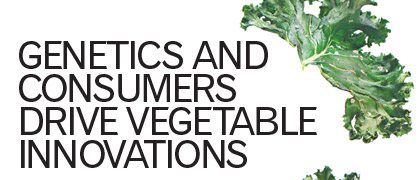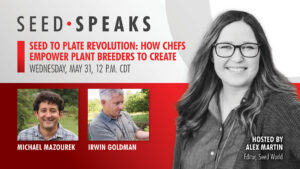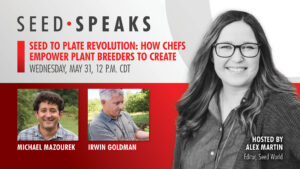The introduction of marker-assisted breeding has undoubtedly been a significant breakthrough for plant breeders. The technology has increased the speed of delivery of new products and allowed for new gene combinations that were not previously possible.
Monsanto’s breeders are using advanced breeding tools to bring added-value seeds to farmers around the world faster by investing in trait-linked molecular markers in 14 crops. “Today, over 200 traits that can be marker-selected are being used to accelerate new product development,” says Marlin Edwards, global vegetable R&D lead for Monsanto.
Specific examples of new varieties made possible by this technology are such things as seedless watermelon, super sweet corn and virus-resistant squash. “This technology has allowed for increased yields and resistances to pests and diseases in many crops, as well as the introduction of beneficial traits for nutrition, taste, aroma, color and shelf life,” says Teresa Mitzel, head of vegetable product evaluation, Syngenta North America. Syngenta estimates that new developments in conventional plant breeding technology, such as marker and genomic-assisted techniques (that can select and breed in a number of required traits simultaneously), could reduce new variety development times from 12 to 15 years to eight years or fewer, depending upon the crop.
Genome Sequencing
Work to sequence the genomes of a number of vegetables continues worldwide. Potato, cucumber and Chinese cabbage were among the first vegetables to be sequenced. Genomes of pests and diseases such as diamondback moth, pea aphid and the fungal organism that causes downy mildew have also been sequenced.
Genome sequencing combined with powerful computational analysis tools is allowing breeders to accelerate the breeding process and has reduced costs considerably. “This technology allows us to have some standard adaptable approaches,” says Michael Mazourek, professor of plant breeding at Cornell University. “Previously, if we wanted to map a gene and develop a molecular marker, that would burn through a few hundred thousand dollars over a few years. Now we can do it for $10,000 in a month.”
But it’s DNA sequencing tools that have allowed researchers to make the biggest leap forward, says Mazourek. New techniques such as genotyping provide a better understanding of the hereditary makeup of plants. “Genotyping by sequence means you can develop your work with a great awareness of all the diversity that’s potentially available to you,” says Mazourek. “It allows me to get the DNA information about the traits of a natural population together in a month or two.”
Bioinformatics is speeding up the analysis of genetic information and is moving towards automation of the selection process. “We’re trying to train computers to build statistical models that will do the selection for us,” says Mazourek.
The Human Element
The one thing a computer model can’t do, however, is allow for human preferences. “In horticultural crops the part the program can’t do is attend to non-commodity aspects,” says Mazourek. “For example, a heart-shaped tomato that becomes the latest huge craze a statistical model could never predict that happening.”
The horticultural industry remains very much a world where trends are driven by consumer preference. “Consumer-oriented traits have always been important, such as flavor and diversity of products,” says Rick Falconer, the U.S. managing director for Dutch breeder Rijk Zwaan and also chair of the American Seed Research Foundation’s vegetable and flower research committee. “Seed companies are doing more consumer research projects, more downstream breeding direction and working towards tailoring specific vegetables for different customers.”
“Seed companies are doing more consumer research projects, more downstream breeding direction and working towards tailoring specific vegetables for different customers.”
|
Local food and organic movements have had a big influence in the marketplace, which feeds back into breeding programs. “People are looking for more heritage and heirloom flavors,” says Mazourek. “Things that start in organic or local food movements are having a ripple effect and major industry players and many others are interested in making that a part of their portfolio.”
More people are also keen on trying to grow their own food and want to know what will grow in their geographic area. That’s driving the development of region-specific varieties and smaller independent seed companies are popping up to serve these niches.
“We went from having lots of smaller seed companies that were getting materials out of land-grant universities, to a few large companies with incredible resources that they focused on a handful of problems and opportunities,” says Mazourek. “Now we’re seeing a lot of small and regional seed companies back selling all these niche opportunities that have been left open.”
What’s Cooking?
Celebrity chefs are also doing their part to educate consumers about “designer” type vegetables, while resurrecting some traditional favorites by preparing them in new ways. After chef Dan Barber of Blue Hill Restaurant in New York City published a recipe for kale chips in Bon Appetit magazine, seed companies reported a huge spike in kale seed sales.
“By linking chefs and breeders, it’s creating a great dialogue,” says Mazourek. “We get information back to influence the breeding program and the chef is getting great new material.”
Consumers are also demanding smaller produce, driven partly by convenience but also to make vegetables more kid-friendly. “Parents are really engaged in what they’re feeding their kids,” says Mazourek. “One of our big interests is what will appeal to a kid in terms of color, flavor and size that will make eating fun.”
Breeding for the Unknown
In an industry that’s largely about taste, keeping everyone happy means developing products to meet the needs of seed companies, growers, retailers and consumers.
Monsanto’s vegetable seeds division is focused on innovation to improve the quality and productivity of vegetables, says Edwards. “We are putting a lot of effort and resources into developing not only agronomic traits (like harvestable yield, insect and disease resistance), but also consumer (taste and overall appeal) and chain (shelf life) traits,” he says.
The challenge that remains is that breeders are more often than not breeding for the unknown, whether that’s erratic consumer tastes, climates, or new pests and diseases. “An example is downy mildew, which has broken all the resistances and now looks to be overwintering in greenhouses,” says Mazourek. “Insect pests and different pathogens are moving or evolving in new ways and have a lot of us scrambling to be able to address that.”
The importance of continued vegetable seed research is obvious and a collaborative approach from all industry players is being encouraged by ASRF through its permanent research fund. “Through the American Seed Trade Association, companies contribute to this research fund and every year when we have our annual meetings, we discuss what problems we have in our industry that we can solve through research as a group,” says Falconer. “If a new disease comes to a crop like lettuce or broccoli, it’s difficult to solve those problems as an individual seed company. But as an industry we can pull together and solve a problem collectively which is affecting all of us.”
Angela Lovell













